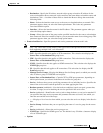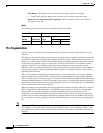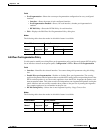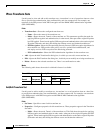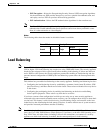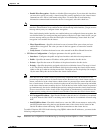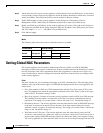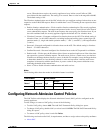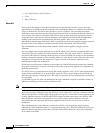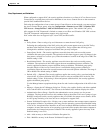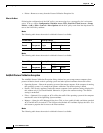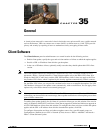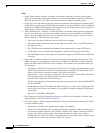
34-23
Cisco ASDM User Guide
OL-16647-01
Chapter 34 IKE
Configuring Network Admission Control Policies
server. When the timer expires, the security appliance tries to initiate a new EAP over UDP
association with the remote host. The setting is in seconds. Enter a value in the range 60 to 86400.
The default setting is 180.
The Clientless Authentication area of the NAC window lets you configure settings for hosts that are not
responsive to the EAPoUDP requests. Hosts for which there is no CTA running do not respond to these
requests.
• Enable clientless authentication—Click to enable clientless authentication. The security appliance
sends the configured clientless username and password to the Access Control Server in the form of
a user authentication request. The ACS in turn requests the access policy for clientless hosts. If you
leave this attribute blank, the security appliance applies the default ACL for clientless hosts.
• Clientless Username—Username configured for clientless hosts on the ACS. The default setting is
clientless. Enter 1 to 64 ASCII characters, excluding leading and trailing spaces, pound signs (#),
question marks (?), single and double quotation marks (“ ” and "), asterisks (*), and angle brackets
(< and >).
• Password—Password configured for clientless hosts on the ACS. The default setting is clientless.
Enter 4 – 32 ASCII characters.
• Confirm Password—Password configured for clientless hosts on the ACS repeated for validation.
• Enable Audit—Click to pass the IP address of the client to an optional audit server if the client does
not respond to a posture validation request. The audit server, such as a Trend server, uses the host
IP address to challenge the host directly to assess its health. For example, it may challenge the host
to determine whether its virus checking software is active and up-to-date. After the audit server
completes its interaction with the remote host, it passes a token to the posture validation server,
indicating the health of the remote host.
• None—Click to disable clientless authentication and audit services.
Modes
The following table shows the modes in which this feature is available:
Configuring Network Admission Control Policies
The NAC Policies table displays the Network Admission Control (NAC) policies configured on the
security appliance.
To add, change, or remove a NAC policy, do one of the following:
• To add a NAC policy, choose Add. The Add NAC Framework Policy dialog box opens.
• To change a NAC policy, double-click it, or select it and click Edit. The Edit NAC Framework Policy
dialog box opens.
• To remove a NAC policy, select it and click Delete.
The following sections describe NAC, its requirements, and how to assign values to the policy attributes:
• About NAC
Firewall Mode Security Context
Routed Transparent Single
Multiple
Context System
• — • ——



